These kinds of skills are increasingly seen as vital for the Navy to survive a future large-scale maritime conflict.

The U.S. Navy amphibious assault ship, the former USS Bonhomme Richard, which was removed from service following a devastating fire last year, performed one final duty when it hosted a battle damage repair exercise before being scrapped.
The salvage exercise took place using the hulk of the warship as it was under tow in the Gulf of Mexico and should ensure that crews are better able to deal with these kinds of situations, should they occur in the future, in peacetime, or during a conflict.
According to Seapower Magazine, the battle damage repair drill was run this summer when the Bonhomme Richard was around 300 miles from its final destination, Brownsville, Texas, where it was brought for scrapping, after having much of its superstructure removed in its homeport of San Diego, California.
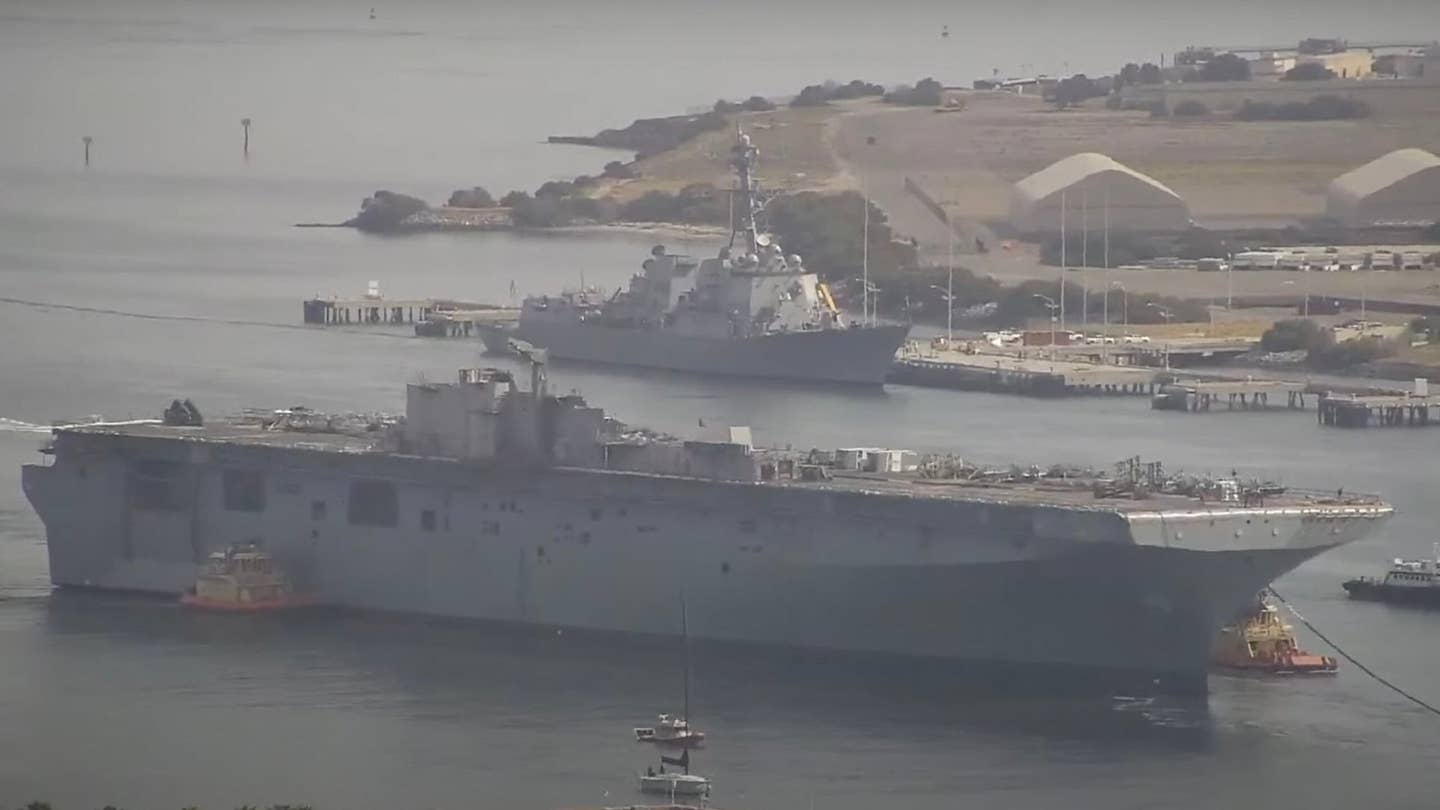
The former amphibious assault ship USS Bonhomme Richard under tow earlier this year, heading from Naval Base San Diego, California, to Brownsville, Texas., @SANDIEGOWEBCAM VIA @WARSHIPCAM
Among the sailors involved in the exercise were mobile diving and salvage personnel and divers.
Essentially, battle damage repair teams, including operational forces, mobile diving, and salvage elements, are the first line of response if a warship suffers serious damage, regardless of how it’s inflicted.
Their job is to contain the damage, stabilize the vessel, and ensure that it can be brought to one of the Navy’s regional maintenance centers or a public shipyard for more extensive repair work
“All of the NAVSEA [Naval Sea Systems Command] commands [and] fleet commands were involved, said Rear Admiral Eric Ver Hage, commander of the Regional Maintenance Center and director of Surface Ship Maintenance and Modernization for NAVSEA.
“They were able to cut metal, flood spaces, de-water spaces, patch the holes at sea; it was really, really realistic,” Ver Hage told the American Society of Naval Engineers Fleet Maintenance and Modernization Symposium, Seapower Magazine reported.
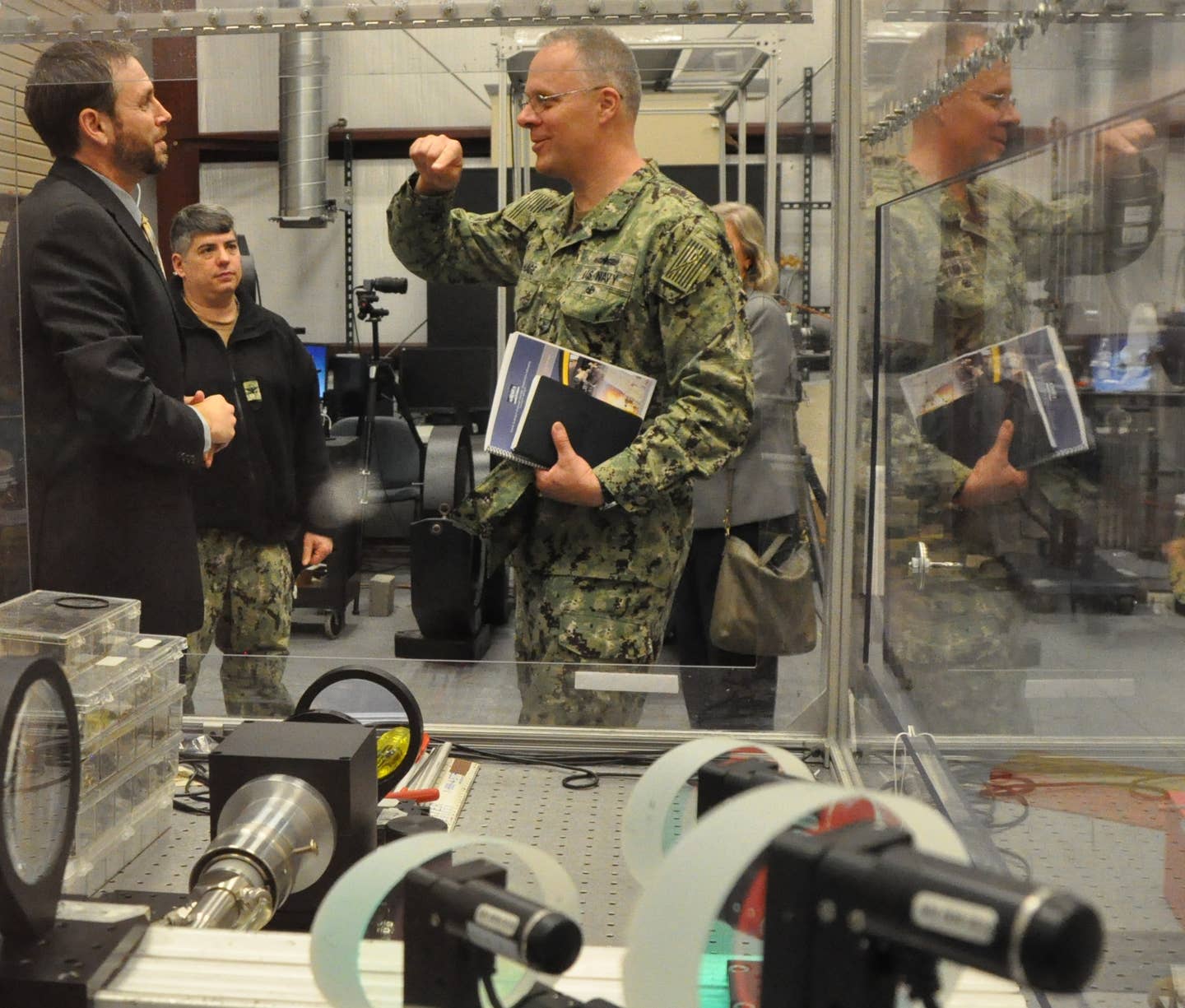
Rear Admiral Eric Ver Hage (right) discusses high-energy laser testing at Naval Surface Warfare Center Dahlgren Division (NSWCDD)., U.S. Navy
Ver Hage also confirmed that the exercise aboard the Bonhomme Richard was likely the first of a number of similar efforts, all with the goal of boosting the Navy’s ability to conduct battle damage repair quickly and effectively.
These kinds of skills would be paramount during any kind of large-scale conflict in which American warships were under threat, as well as in response to terror attacks or in other asymmetric scenarios.
“We’re going to do more of that,” the admiral said, in reference to this summer’s battle damage repair exercise.
Ver Hage provided the example of the al-Qaeda attack on the Arleigh Burke class guided-missile destroyer USS Cole in the Yemeni port of Aden in October 2000, in which suicide terrorists exploded a small boat alongside the warship as it was refueling, killing 17 American sailors, injuring many more, and causing considerable damage to the vessel.
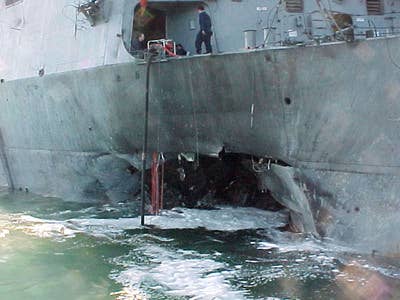
Port-side view showing the damage sustained by the USS Cole on October 12, 2000., via U.S. Navy
As well as the terror threat, which has only increased since 2000, the new era of great power competition is increasingly putting the United States on a collision course with China and, in particular, its maritime interests, and growing naval might, in the wider Asia Pacific region.
At the same time, the Russian Navy is diminished compared to its Soviet predecessor, but is increasingly active, including closer to U.S. shores.
Meanwhile, the example of the USS Bonhomme Richard shows that battle damage repair skills are just as important in peacetime.
According to Ver Hage, use was made of innovative tools to help tackle the fire, including expertise from the oil and gas industry, drones for close-in inspection, and firefighting helicopters, among them Navy Seahawks that made 1,649 water drops over a four-day period.
However, the Navy ultimately identified a catalog of errors in the response to the Bonhomme Richard fire. Details of the investigation report demonstrate that the crew was unprepared to deal with the fire, which was allegedly started deliberately by a sailor while the warship was undergoing maintenance.
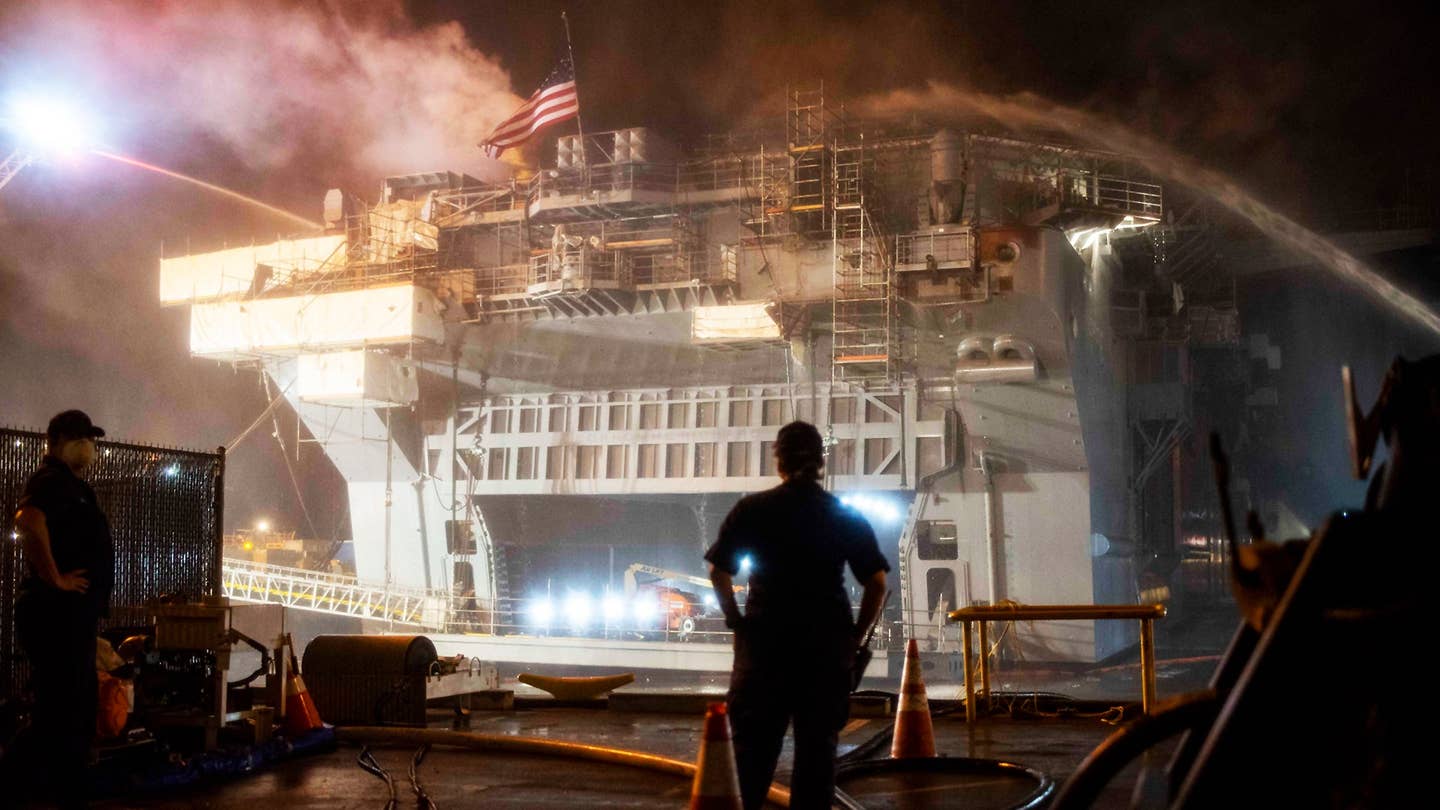
Firefighters tackle the blaze aboard the USS Bonhomme Richard in port in San Diego., COMMANDER, NAVAL SURFACE FORCE—PUBLIC DOMAIN
“Although the fire was started by an act of arson, the ship was lost due to an inability to extinguish the fire,” Vice Admiral Scott Conn, the former U.S. 3rd Fleet commander stated in his investigation, details of which were first reported by USNI News.
Earlier this summer, and prior to the release of the Bonhomme Richard investigation, the Government Accountability Office also highlighted the Navy’s deficiencies in repairing battle-damaged warships, especially in high-intensity combat operations against advanced adversaries.
“Navy officials we interviewed generally agreed that the Navy could handle a single battle damage event but were uncertain how the Navy might handle multiple simultaneous or near-simultaneous events,” the report stated.
The loss of a U.S. Navy warship is today a rare occurrence. Compared to more than 350 warships and patrol craft sunk or damaged beyond repair during World War II, less than 30 have been subject to the same fates after 1945, according to figures published by USNI. However, as Ver Hage, the Government Accountability Office, and others now warn, this situation could change for the worse in the future.
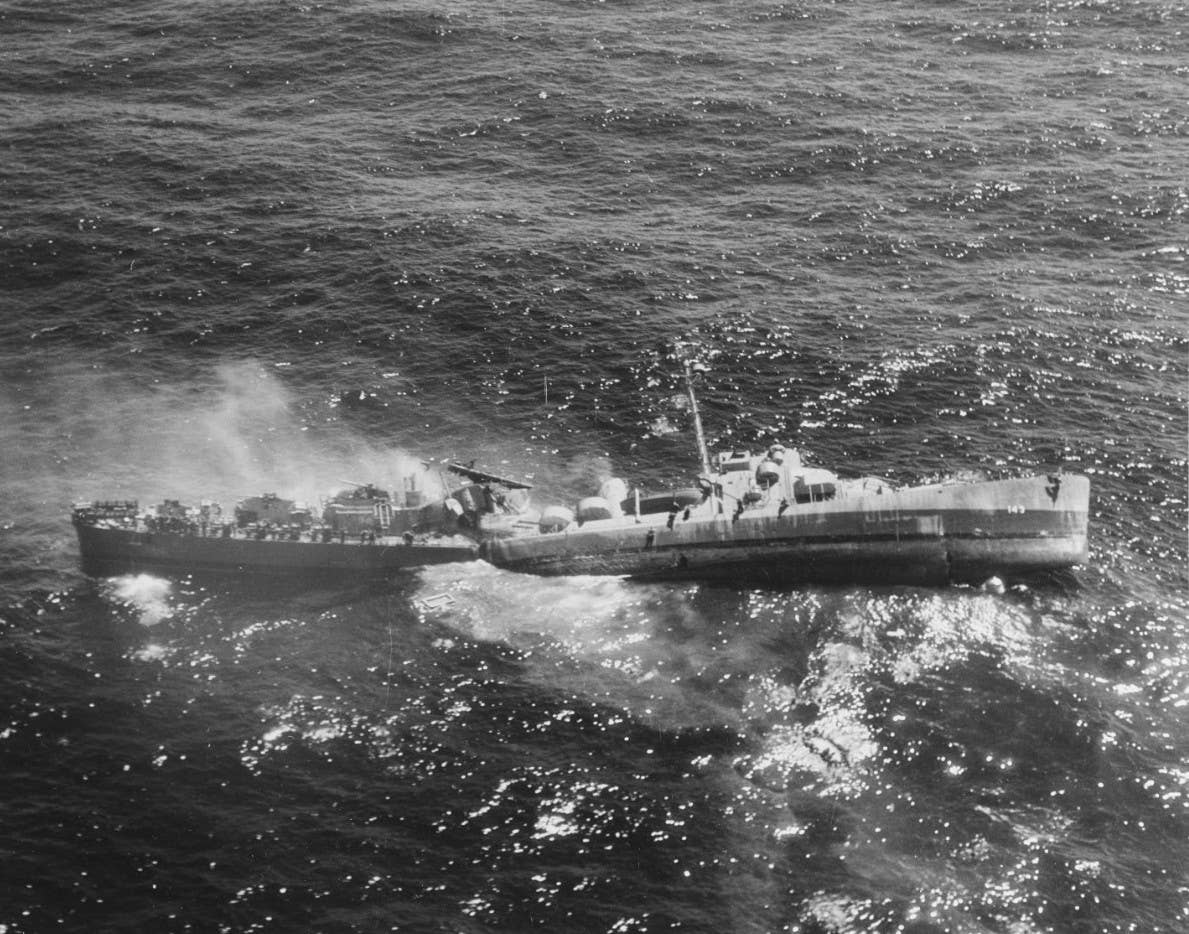
A reminder of more dangerous times: the destroyer escort USS Fiske (DE-143) after it was torpedoed by a German U-boat north of the Azores on August 2, 1944. Thirty-three of the crew died and 50 more were badly wounded. , U.S. Navy
As Commander Leineweber, officer-in-charge of Amphibious Construction Battalion Two, Detachment 113, at Navy Operational Support Center, wrote in the August 2020 issue of Proceedings: “If the United States goes to war with a peer adversary, some warships will suffer severe combat damage.
Consider that it took nearly two years to repair the USS John S. McCain (DDG-56) and USS Fitzgerald (DDG-62) following their 2017 collisions.
In a fight with China for control of the Pacific, the United States will not have that long to get ships back in the fight. Taking years for repairs could cause the United States to lose the next war not long after the first major naval engagement.”
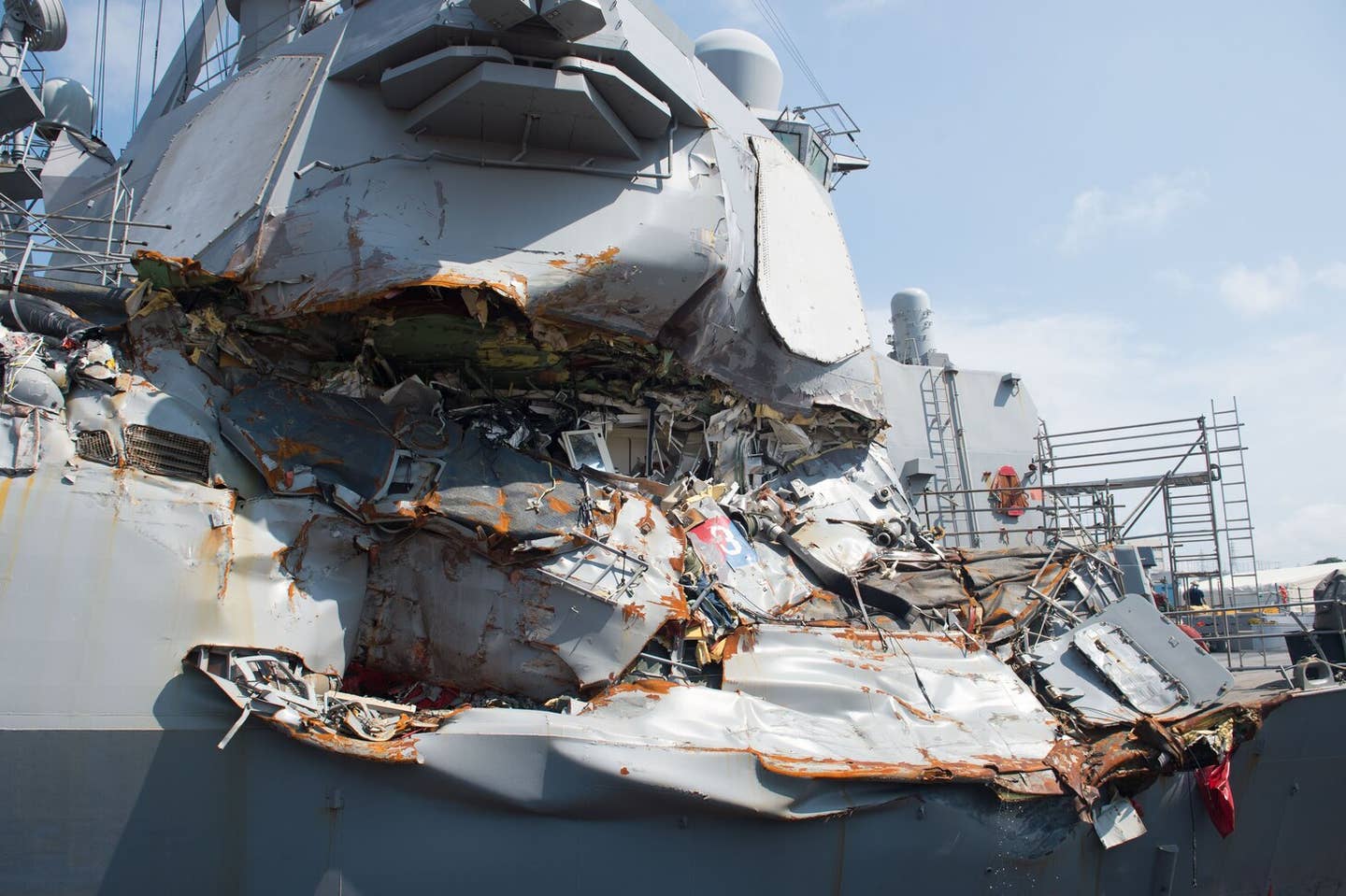
The guided-missile destroyer USS Fitzgerald in dry dock at Yokosuka, Japan, for repairs and damage assessments, in 2017, after a collision with a merchant vessel., U.S. Navy/Petty Officer 2nd Class Christian Senyk
Ver Hage’s plans call for battle damage repairs to be practiced using former Navy ships that have been selected to be destroyed as targets in sink exercises, or SINKEX, of the kind that you can read more about here and here.
In this way, the Navy’s ability to deal with any future fires, as well as other kinds of contingencies, should be enhanced.
But many questions still remain, including just how badly damaged or degraded in terms of mission effectiveness a warship would have to be before being taken out of commission during a conflict.
By being able to fix ships, even in the most basic ways, more quickly, the idea of what is a battle-worthy vessel may begin to change substantially.





